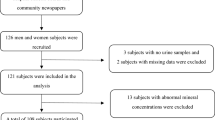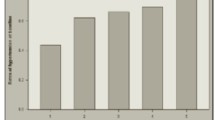Abstract
Antioxidant intake may be linked to a reduction of the chronic low-grade inflammatory state related to obesity and several accompanying disorders such as insulin resistance, cardiovascular diseases, and metabolic syndrome. So, the aim of this study was to evaluate the potential associations between nail trace elements and several indicators in healthy young adults, emphasizing on the putative effect of antioxidant trace element intake on inflammation-related marker concentrations. This study enrolled 149 healthy young adults, whose anthropometrical and blood pressure values as well as lifestyle features were analyzed. Fasting blood samples were collected for the biochemical and inflammation-related measurements (C-reactive protein, tumor necrosis factor-alpha (TNF-α), interleukin (IL)-6, IL-18, and homocysteine). Nail samples were collected for the analysis of selenium, zinc, and copper concentrations. Our results showed that nail selenium was negatively associated with IL-18; nail zinc concentrations were inversely related to circulating IL-6, IL-18, and TNF-α, whereas nail copper (Cu) and Cu/selenium values were negatively correlated with homocysteine levels and the Cu/zinc ratio was unaffected. In conclusion, nail content on some trace elements related to antioxidant defense mechanisms seems to be associated with several inflammation-related markers linked to chronic diseases in apparently healthy young adults, which is of interest to understand the role of antioxidant intake.


Similar content being viewed by others
References
Vincent HK, Taylor AG (2006) Biomarkers and potential mechanisms of obesity-induced oxidant stress in humans. Int J Obes (Lond) 30:400–418
Brenneisen P, Steinbrenner H, Sies H (2005) Selenium, oxidative stress, and health aspects. Mol Aspects Med 26:256–267
Fulop T, Tessier D, Carpentier A (2006) The metabolic syndrome. Pathol Biol (Paris) 54:375–386
Dandona P, Aljada A, Bandyopadhyay A (2004) Inflammation: the link between insulin resistance, obesity and diabetes. Trends Immunol 25:4–7
Moreno-Aliaga MJ, Campión J, Milagro FI et al (2005) Adiposity and proinflammatory state: the chicken or the egg. Adipocytes 1:1–16
Scheurig AC, Thorand B, Fischer B et al (2008) Association between the intake of vitamins and trace elements from supplements and C-reactive protein: results of the MONICA/KORA Augsburg study. Eur J Clin Nutr 62:127–137
Ferencik M, Ebringer L (2003) Modulatory effects of selenium and zinc on the immune system. Folia Microbiol (Praha) 48:417–426
Gibson RS (2005) Principles of nutritional assessment. Oxford University Press, New York
Friedewald WT, Levy RI, Fredrickson DS (1972) Estimation of the concentration of low-density lipoprotein cholesterol in plasma, without use of the preparative ultracentrifuge. Clin Chem 18:499–502
Navarro-Blasco I, Alvarez-Galindo JI (2004) Selenium content of Spanish infant formulae and human milk: influence of protein matrix, interactions with other trace elements and estimation of dietary intake by infants. J Trace Elem Med Biol 17:277–289
Hunter DJ, Morris JS, Chute CG et al (1990) Predictors of selenium concentration in human toenails. Am J Epidemiol 132:114–122
Satia JA, King IB, Morris JS et al (2006) Toenail and plasma levels as biomarkers of selenium exposure. Ann Epidemiol 16:53–58
Sukumar A, Subramanian R (2007) Relative element levels in the paired samples of scalp hair and fingernails of patients from New Delhi. Sci Total Environ 372:474–479
Van Dael P, Davidsson L, Munoz-Box R et al (2001) Selenium absorption and retention from a selenite- or selenate-fortified milk-based formula in men measured by a stable-isotope technique. Br J Nutr 85:157–163
Longnecker MP, Stampfer MJ, Morris JS et al (1993) A 1-y trial of the effect of high-selenium bread on selenium concentrations in blood and toenails. Am J Clin Nutr 57:408–413
Slotnick MJ, Nriagu JO (2006) Validity of human nails as a biomarker of arsenic and selenium exposure: a review. Environ Res 102:125–139
Lonnerdal B (1989) Trace element absorption in infants as a foundation to setting upper limits for trace elements in infant formulas. J Nutr 119:1839–1844
Ece A, Uyanik BS, Iscan A et al (1997) Increased serum copper and decreased serum zinc levels in children with iron deficiency anemia. Biol Trace Elem Res 59:31–39
Sandstrom B (2001) Micronutrient interactions: effects on absorption and bioavailability. Br J Nutr 85:S181–S185
Cunzhi H, Jiexian J, Xianwen Z et al (2003) Serum and tissue levels of six trace elements and copper/zinc ratio in patients with cervical cancer and uterine myoma. Biol Trace Elem Res 94:113–122
Gupta SK, Singh SP, Shukla VK (2005) Copper, zinc, and Cu/Zn ratio in carcinoma of the gallbladder. J Surg Oncol 91:204–208
Kucharzewski M, Braziewicz J, Majewska U et al (2003) Copper, zinc, and selenium in whole blood and thyroid tissue of people with various thyroid diseases. Biol Trace Elem Res 93:9–18
Wang CT, Huang KC, Pan TM et al (2008) Variations in the concentrations of Cu and Zn and in the ratio of Cu to Zn in whole blood and hair samples from hepatocellular carcinoma patients and from healthy controls in Taiwan. Spectrosc Lett 41:144–150
Gomez-Aracena J, Martin-Moreno JM, Riemersma RA et al (2002) Association between toenail scandium levels and risk of acute myocardial infarction in European men: the EURAMIC and heavy metals study. Toxicol Ind Health 18:353–360
Gomez-Aracena J, Riemersma RA, Gutierrez-Bedmar M et al (2006) Toenail cerium levels and risk of a first acute myocardial infarction: the EURAMIC and heavy metals study. Chemosphere 64:112–120
Dandona P, Aljada A, Chaudhuri A et al (2005) Metabolic syndrome: a comprehensive perspective based on interactions between obesity, diabetes, and inflammation. Circulation 111:1448–1454
Chen MD, Song YM, Tsou CT et al (2000) Leptin concentration and the Zn/Cu ratio in plasma in women with thyroid disorder. Biol Trace Elem Res 75:99–105
Eiserich JP, van der Vliet A, Handelman GJ et al (1995) Dietary antioxidants and cigarette smoke-induced biomolecular damage: a complex interaction. Am J Clin Nutr 62:1490S–1500S
Mezzetti A, Lapenna D, Pierdomenico SD et al (1995) Vitamins E, C and lipid peroxidation in plasma and arterial tissue of smokers and non-smokers. Atherosclerosis 112:91–99
Zanchi NE, Bechara LR, Tanaka LY et al (2008) Moderate exercise training decreases aortic superoxide production in myocardial infarcted rats. Eur J Appl Physiol 104:1045–1052
Rousseau AS, Margaritis I, Arnaud J et al (2006) Physical activity alters antioxidant status in exercising elderly subjects. J Nutr Biochem 17:463–470
Satyanarayana S, Sekhar JR, Kumar KE et al (2006) Influence of selenium (antioxidant) on gliclazide induced hypoglycaemia/anti hyperglycaemia in normal/alloxan-induced diabetic rats. Mol Cell Biochem 283:123–127
Sheng XQ, Huang KX, Xu HB (2005) Influence of alloxan-induced diabetes and selenite treatment on blood glucose and glutathione levels in mice. J Trace Elem Med Biol 18:261–267
Czernichow S, Couthouis A, Bertrais S et al (2006) Antioxidant supplementation does not affect fasting plasma glucose in the supplementation with antioxidant vitamins and minerals (SU.VI.MAX) study in France: association with dietary intake and plasma concentrations. Am J Clin Nutr 84:395–399
Ghayour-Mobarhan M, Taylor A, New SA et al (2005) Determinants of serum copper, zinc and selenium in healthy subjects. Ann Clin Biochem 42:364–375
Brown BG, Zhao XQ, Chait A et al (2001) Simvastatin and niacin, antioxidant vitamins, or the combination for the prevention of coronary disease. N Engl J Med 345:1583–1592
Zulet MA, Puchau B, Navarro C et al (2007) Inflammatory biomarkers: the link between obesity and associated pathologies. Nutr Hosp 22:511–527
Musil F, Zadak Z, Solichova D et al (2005) Dynamics of antioxidants in patients with acute pancreatitis and in patients operated for colorectal cancer: a clinical study. Nutrition 21:118–124
Hermsdorff HH, Zulet MA, Puchau B et al (2009) Association of retinol-binding protein-4 with dietary selenium intake and other lifestyle features in young healthy women. Nutrition 25:392–399
Zulet MA, Puchau B, Hermsdorff HH et al (2009) Dietary selenium intake is negatively associated with serum sialic acid and metabolic syndrome features in healthy young adults. Nutr Res 29:41–48
Puchau B, Zulet MA, González de Echávarri A et al (2008) Selenium intake reduces serum C3, an early marker of metabolic syndrome manifestations, in healthy young adults. Eur J Clin Nutr 63:858–864
Puchau B, Zulet MA, Urtiaga G et al (2009) ADMA association with antioxidants intake in healthy young adults: a role as an indicator of metabolic syndrome features. Metabolism (in press)
Alvares Delfino VD, de Andrade Vianna AC, Mocelin AJ et al (2007) Folic acid therapy reduces plasma homocysteine levels and improves plasma antioxidant capacity in hemodialysis patients. Nutrition 23:242–247
Rajdl D, Racek J, Trefil L et al (2007) Effect of white wine consumption on oxidative stress markers and homocysteine levels. Physiol Res 56:203–212
Acknowledgments
This study is supported by the Línea Especial about Nutrition, Obesity and Health (LE/97), the Health Department of the Government of Navarra (22/2007), Ibercaja, the ADA fellowships scheme of the University of Navarra and the Capes Foundation of the Ministry of Education of Brazil (375605-0). We thank Amaia González de Echávarri for her help with the recruitment and the data collection, Verónica Ciáurriz and Ana Lorente for technical assistance, Blanca Martínez de Morentin and Salomé Pérez for assistance with the data collection, and all those who volunteered to participate in the study.
Author information
Authors and Affiliations
Corresponding author
Rights and permissions
About this article
Cite this article
Puchau, B., Zulet, M.Á., Hermsdorff, H.H.M. et al. Nail Antioxidant Trace Elements Are Inversely Associated with Inflammatory Markers in Healthy Young Adults. Biol Trace Elem Res 133, 304–312 (2010). https://doi.org/10.1007/s12011-009-8443-5
Received:
Accepted:
Published:
Issue Date:
DOI: https://doi.org/10.1007/s12011-009-8443-5




